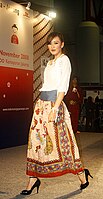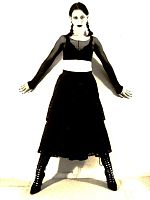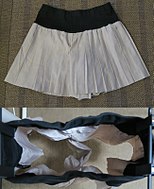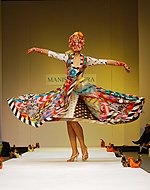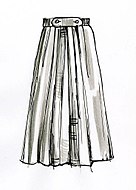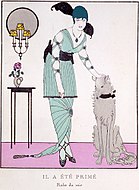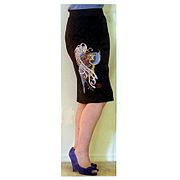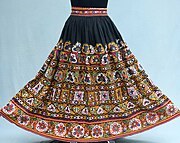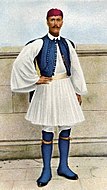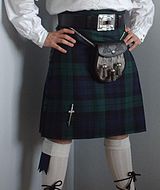Skirt
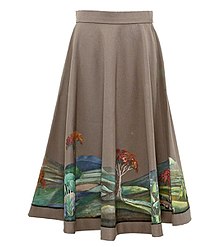 | |
| Type | Clothing worn from the waist or hips. |
|---|---|
A skirt is the lower part of a
At its simplest, a skirt can be a draped garment made out of a single piece of fabric (such as pareos). However, most skirts are fitted to the body at the waist or hips and fuller below, with the fullness introduced by means of darts, gores, pleats, or panels. Modern skirts are usually made of light to mid-weight fabrics, such as denim, jersey, worsted, or poplin. Skirts of thin or clingy fabrics are often worn with slips to make the material of the skirt drape better and for modesty.
In modern times, skirts are very commonly worn by women and girls. Some exceptions include the
The
History
Skirts have been worn since prehistoric times as the simplest way to cover the lower body. Figurines produced by the
A straw-woven skirt dating to 3900 BC was discovered in
Ancient Egyptian garments were mainly made of linen. For the upper classes, they were beautifully woven and intricately pleated.[10] Around 2130 BC, during the Old Kingdom of Egypt, men wore wraparound skirts (kilts) known as the shendyt. They were made of a rectangular piece of cloth wrapped around the lower body and tied in front. By the Middle Kingdom of Egypt, longer skirts, reaching from the waist to ankles and sometimes hanging from the armpits, became fashionable. During the New Kingdom of Egypt, kilts with a pleated triangular section became fashionable for men.[11] Beneath these, a shente, or triangular loincloth whose ends were fastened with cord ties, were worn.[12]
During the Bronze Age, in the Southern parts of Western and Central Europe, wraparound dress-like garments were preferred. However, in Northern Europe, people also wore skirts and blouses.[13]

In the Middle Ages, men and women preferred dress-like garments. The lower part of men's dresses were much shorter in length compared to those for women. They were wide cut and often pleated or gored so that horse riding was more comfortable. Even a knight's armor had a short metal skirt below the breastplate. It covered the straps attaching the upper legs iron cuisse to the breastplate. Technological advances in weaving in the 13th–15th century, like foot-treadle floor looms and scissors with pivoted blades and handles, improved tailoring trousers and tights. They became fashionable for men and henceforth became standard male attire whilst becoming taboo for women.[14][15]
Skirts are still worn by men and women from many cultures, such as the lungi, lehenga, kanga, and sarong worn in South Asia and Southeast Asia, and the kilt worn in Scotland and Ireland.
One of the earliest known cultures to have females wear clothing resembling miniskirts were the Duan Qun Miao (Chinese: 短裙苗), which literally means "Short Skirt Miao". This was in reference to the short miniskirts "that barely cover the buttocks" worn by women of the tribe, and which were probably shocking to observers in premodern and early modern times.[16]
In the Middle Ages, some upper-class women wore skirts over three meters in diameter at the bottom.[citation needed] At the other extreme, the miniskirts of the 1960s were minimal garments that may have barely covered the underwear when the woman was seated. Costume historians[who?] typically use the word "petticoat" to describe skirt-like garments of the 18th century or earlier.
-
Sumerian man wearing a kaunakes, c. 3000 BC
-
Statue of Ramaat, an official from Giza wearing a pleated Egyptian kilt, c. 2250 BC
-
Drawing of a girl's skirt made of wool yarn found in a Bronze Age tomb in Borum Eshøj, Denmark
-
Vinča figurine depicting a skirt
19th century
During the 19th century, the cut of women's
In the 19th century, in the United States and United Kingdom, there was a movement against skirts as part of the
20th and 21st centuries

After 1915, ankle-length skirts were not generally worn in the daytime. For the next fifty years fashionable skirts became short (1920s), then long (1930s), then shorter (in the
Since the 1970s and the rise of pants/trousers for women as an option for all but the most formal of occasions, no one skirt length has dominated fashion for long, with short and ankle-length styles often appearing side by side in fashion magazines and catalogs.
Skirts by geography and ethnicity
East Asia
China
- Han Chinese: Qun, including mamianqun (see also ruqun, qixiong ruqun, qungua categorized under hanfu and maweiqun)
- Miao : duanqunmiao (短裙苗)
Korea
- Koreans: Chima (see also chima jeogori categorized under hanbok)
Basic types

- A-line skirt
- An a-line skirtis a skirt with a slight flare, roughly in the shape of a capital letter A.
- Bell-shaped skirt
- A bell-shaped skirt, flared noticeably from the waist but then, unlike a church bell, cylindrical for much of its length.
- Circle skirt
- A skirt cut in sections to make one or more circles with a hole for the waist, so the skirt is very full but hangs smoothly from the waist without darts, pleats, or gathers.
- Culottes
- A form of divided skirt, split skirt, or pantskirt constructed like a pair of shorts, but hanging like a skirt.[21]
- Divided skirt
- See under: Culottes.
- Full skirt
- A skirt with fullness gathered into the waistband.
- Gored skirt
- A skirt that fits through the waistline and flares at the hem. May be made of from four to twenty-four shaped sections. Dates from the 14th century and much used in the 19th century. Very popular in the late 1860s, mid-1890s, early 20th century, 1930s, 1940s, and now worn as a classic skirt style.[22]
- Inverted pleated skirt
- A skirt made by bringing two folds of fabric to a center line in front and/ or back. May be cut straight at sides or be slightly flared. Has been a basic type of skirt since the 1920s.[22]
- Pleated skirt
- A skirt with fullness reduced to fit the waist by means of regular pleats ('plaits') or folds, which can be stitched flat to hip-level or free-hanging.
- Short skirt
- A skirt with hemline above the knee.
- Slit skirt/Split skirt
- A skirt that has one or more slits (or splits).
- Straight skirt
- A straight skirt or pencil skirt is a tailored skirt hanging straight from the hips and fitted from the waist to the hips by means of darts or a yoke. It may have a vent or kick-pleat set in the hem for ease of walking.
- Underskirt
- Simple, basic skirt over which an overskirt, or drapery, hangs.[22]
- Wrap or wraparound skirt
- A skirt that wraps around the waist with an overlap of material.
Fads and fashions
- Ballerina skirt
- A ballerina skirt is a mid-calf full skirt popular in the 1950s.
- Broomstick skirt
- A light-weight ankle-length skirt with many crumpled pleats formed by compressing and twisting the garment while wet, such as around a broomstick. (1980s and on)
- Bubble skirt
- A bubble skirt, also called tulip skirt or balloon skirt, is a voluminous skirt whose hem is tucked back under to create a "bubble effect" at the bottom. Popular in the 1950s, 1980s and again in the 2010s.[22]
- Cargo skirt
- A cargo skirt is a plain utilitarian skirt with belt loops and numerous large pockets, based on the military style of cargo pantsand popularised in the 1990s.
- Crinoline
- A crinoline is a very full skirt supported by hoops or multiple petticoats, popular at various times from the mid 19th century onwards.
- Dirndl
- A dirndl skirt, (durn′del) is a skirt in the Bavarian-Austrian dirndl style, made of a straight length of fabric gathered at the waist. The style derives from Tyrolean peasant costume.[22]
- Denim skirt
- A denim skirt (or jeans skirt), is a skirt made of denim, often designed like 5-pocket jeans, but found in a large variety of styles.
- Godet skirt
- A godet skirt (go-day’) is a skirt with triangular pieces of fabric inserted upward from the hem to create more fullness. Popular in the 1930s.[22]
- Hobble skirt
- A hobble skirt is a long and tight skirt with a hem narrow enough to significantly impede the wearer's stride.
- Kilt-skirt
- A wrap-around skirt with overlapping aprons in front and pleated around the back. Though traditionally designed as women's wear, it is fashioned to mimic the general appearance of a man's kilt.
- Leather skirt
- A leather skirt is a skirt made of leather.
- Lehenga
- A Gagra choli in North India and Pakistan.[23]
- Maxi skirt
- An ankle-length daytime skirt, popular with women in the late 1960s as a reaction against miniskirts.[22]
- Micromini
- An extremely short miniskirt.
- Mandala skirt
- A skirt with a mandala motif.
- Midi skirt
- A skirt with hem halfway between ankle and knee, below the widest part of the calf. Introduced by designers in 1967 as a reaction to very short mini skirts.[22]
- Mini-crini
- A mini-length version of the crinoline, designed by Vivienne Westwood in the mid 1980s.[24]
- Poodle skirt
- A appliquedpoodle or other decoration (1950s)
- Puffball skirt
- A puffball skirt, also called "puff" or "pouf", is a bouffant skirt caught in at the hem to create a puffed silhouette. Popular in the mid-late 1980s when it was inspired by Westwood's "mini-crini".[25]
- Rah-rah skirt/Cheerleader skirt
- A rah-rah skirt is a short, tiered, and often colourful skirt fashionable in the early-mid-1980s.
- Sarong
- A sarong is a square or rectangle of fabric wrapped around the body and tied on one hip to create a skirt that can be worn by both sexes
- Samare
- A Samare was a long-skirted jacket, in which a loose jacket with extra frills hung down to the knees in the style of a gown.[26][27]
- Scooter skirt
- A scooter skirt or skort (variant), a skirt that has an attached pair of shorts underneath for modesty. Alternatively, but with similar effect, a pair of shorts incorporating a skirt-like flap across the front of the body.
- Skater skirt
- A short, high-waisted circle skirt with a hemline above the knee, often made of lighter materials to give the flowing effect that mimics the skirts of figure skaters.
- Squaw dress
- A squaw dress or fiesta dress is a one or two piece outfit based on Native American clothing. Fashionable in the 1940s and 50s.[28]
- Swing skirt
- A flared skirt, circular or cut in gores, fitted at hips with a wide flare at the hem. Popular in the late 1930s and at interval since. Very popular in the mid-1980s.[22]
- T-skirt
- A T-skirt is a skirt made from a tee-shirt. The T-skirt is generally modified to result in a pencil skirt, with invisible zippers, full length two-way separating side zippers, as well as artful fabric overlays and yokes.
- Tiered skirt
- A skirt made of several horizontal layers, each wider than the one above, and divided by stitching. Layers may look identical in solid-colored garments, or may differ when made of printed fabrics.
- Prairie skirt
- A prairie skirt, variant of a tiered skirt, is a flared skirt with one or more flounces or tiers (1970s and on)
- Trouser skirt
- A trouser skirt or culotte is a straight skirt with the part above the hips tailored like men's trousers, with belt loops, pockets, and fly front.
- Tulip skirt
- see under: Bubble skirt.
Lengths
-
Ankle-length skirt or 'maxi,' a term introduced in the late 1960s
-
Mid-calf length or 'midi,' a term introduced in the 1970s.
-
Microskirt, an extremely short miniskirt.
-
High-low/hi-lo skirt, a skirt with an asymmetrical hemline.
Dancing and skirts
Many forms of dancing require females to wear skirts or dresses, either by convention or competition rules. In
International norms regarding skirts
Since 2004 the International Skating Union has allowed women to wear trousers instead of skirts in competition if they wish.[29]
Law regarding skirts
In the 1980s in Puerto Rico, Ana Irma Rivera Lassén was not allowed to enter court in trousers and was told to wear a skirt. She sued the judge and won.[30]
In 2022, the United States Court of Appeals for the Fourth Circuit ruled against the Charter Day School in North Carolina, which had required girls to wear skirts due to the idea that girls are "fragile vessels" deserving "gentle" treatment from boys. The court ruled the requirement was unconstitutional.[31]
School policy regarding skirts
The skirt is a part of uniforms for girls in many schools around the world, with lengths varying depending on local culture. The pleated tartan skirt began as a component of girls' school uniforms in the early twentieth century in the United Kingdom.[32] Most UK schools now allow girls to wear trousers, but many girls still wear skirts in primary and secondary schools, even where the choice of trousers is given. In the late 20th and early 21st century, many schools began changing their uniform rules to allow trousers for girls amidst opposition to skirts-only policies - the most publicised possibly being Jo Hale vs Whickham Comprehensive in 2000.[33] Although it is commonly accepted that girls may wear trousers to school, no test case is known to have been brought before the courts, making the legal position uncertain on requiring skirts as part of girls' uniforms. The rule is still enforced in many schools, particularly independent and selective state schools. In fact, United Kingdom government guidelines expressly state the decision of allowing girls to wear trousers is with individual schools.[34]
Male wear

There are a number of garments marketed to men which fall under the category of "skirt" or "dress". These go by a variety of names and form part of the traditional dress for men from various cultures. Usage varies – the
- The presidential mansionwearing a short version of this historic costume.
- The gho is a knee-length robe worn by men in Bhutan. They are required to wear it every day as part of national dress in government offices, in schools and on formal occasions.[35]
- The hakama is worn in Japan. There are two types of hakama, divided umanori (馬乗り, "horse-riding hakama") and undivided andon hakama (行灯袴, "lantern hakama"). The umanori type has wide and divided legs, similar to culottes. Some hakamas are pleated.
- The kilt is a skirt of Gaelic and Celtic history, part of the Scottish national dress in particular, and is worn formally and to a lesser extent informally. Irish and Welsh kilts also exist but are not so much a part of national identity.
- The sarong is a piece of cloth that may be wrapped around the waist to form a skirt-like garment. Sarongs exist in various cultures under various names, including the pareo and lavalava of the Hawaiian islands and Polynesia (Samoa, Tonga, Tahiti, and Fiji), the Indian dhoti and lungi, and the South Indian and Maldivian mundu.
Aside from the wearing of kilts, in the Western world skirts, dresses, and similar garments are generally viewed exclusively as women's clothing which, historically, was not always the case.[36] However, some Western men have taken up skirts as forms of civil protest.[37] Other Western men advocate skirts as a measure of co-equality between women and men.
Gallery
- Basic types
-
A-line
-
Circle
-
Full (in motion)
-
Pleated
- Fads and fashions
- World culture
-
Kutchi embroidery long skirt
See also
References
- ^ "Skirt". Oxford English Dictionary (Online ed.). Oxford University Press. (Subscription or participating institution membership required.)
- ^ Fogg, Marnie (2011) The Fashion Design Directory. London: Thames & Hudson. p.165,316
- ^ Cvekic, Ljilja (12 November 2007). "Prehistoric women had passion for fashion". Reuters. Archived from the original on 19 September 2016. Retrieved 19 September 2016.
- ^ "5,900-year-old women's skirt discovered in Armenian cave". News Armenia. September 13, 2011. Archived from the original on October 10, 2017. Retrieved September 14, 2011.
- ^ http://translate.enacademic.com/γαυνάκης/el/[permanent dead link] [bare URL]
- ^ Chicago Assyrian Dictionary, Volume 5 (PDF). p. 134. Archived (PDF) from the original on 2022-09-22. Retrieved 2023-04-06.
- ^ Boucher, Francois (1987): 20.000 Years of Fashion: The History of Costume and Personal Adornment. New York: Harry N. Abrams
- ^ The Bible: Genesis 12:4-5
- ^ Roberts, J.M. (1998): The Illustrated History of the World. Time-Life Books. Volume 1. p. 84
- ^ Barber, Elisabeth J.W. (1991): Prehistoric Textiles: The Development of Cloth in the Neolithic and Bronze Ages with Special Reference to the Aegean. Princeton: Princeton University Press. p.12
- ^ Rief Anawalt, Patricia (2007): The Worldwide History of Dress. London: Thames & Hudson. p. 25
- ^ Rief Anawalt, Patricia (2007): The Worldwide History of Dress. London: Thames & Hudson. p. 24
- ^ Koch-Mertens, Wiebke (2000): Der Mensch und seine Kleider: Die Kulturgeschichte der Mode bis 1900. Artemis & Winkler: Düsseldorf Zürich. pp. 49-51
- ^ Tortora, Phyllis G. et al. (2014): Dictionary of Fashion. New York: Fairchild Books. p. 11
- ^ Koch-Mertens, Wiebke (2000): Der Mensch und seine Kleider: Die Kulturgeschichte der Mode bis 1900. Artemis & Winkler: Düsseldorf Zürich. pp. 156-162
- ISBN 0-295-97528-8.
- ISBN 978-0-89672-616-1.
- ^ "Elizabeth Smith Miller - Women's Rights National Historical Park (U.S. National Park Service)". Nps.gov. Archived from the original on 2014-02-03. Retrieved 2018-12-23.
- ^ "Amelia Bloomer - Women's Rights National Historical Park (U.S. National Park Service)". Nps.gov. Archived from the original on 2022-02-02. Retrieved 2018-12-23.
- from the original on 2022-05-05. Retrieved 2022-06-19.
- ISBN 9780486433806.
- ^ a b c d e f g h i Tortora, Phyllis G. et al. (2014): Dictionary of Fashion. New York: Fairchild Books. pp. 370-374
- ^ "Social Science a Textbook in History for Class IX as per New Syllabus". google.co.in.
- ^ Staff writer. "Vivienne Westwood designs". Victoria and Albert Museum. Archived from the original on 6 September 2015. Retrieved 5 June 2015.
- ISBN 9780300103991.
- ISBN 978-0-87282-001-2.
- ^ McClellan, Elisabeth (1906). Historic Dress, 1607-1800: With an Introductory Chapter on Dress in the Spanish and French Settlements in Florida and Louisiana. Lane. p. 133.
- ^ Driver, Maggie (21 April 2016). "The squaw dress: Tucson's controversial but unique fashion history". Arizona Sonora News. Archived from the original on 2018-01-18. Retrieved 2018-01-17.
- ^ "Slovak Pair Tests New ISU Costume Rules - Skate Today". Archived from the original on 2018-10-03. Retrieved 2022-06-19.
- ^ "Mujer de intersecciones" (in Spanish). Guaynabo, Puerto Rico: El Nuevo Día. 27 May 2012. Archived from the original on 19 February 2016. Retrieved 19 February 2016.
- ^ "North Carolina charter school's skirt requirement for girls unconstitutional, court rules". MSN. Archived from the original on 2022-06-15. Retrieved 2022-06-19.
- ISBN 978-0748644490.
- ^ Rebecca Smithers Education Correspondent (2000-02-24). "Girl wins battle to wear trousers to school | Education". The Guardian. Archived from the original on 2014-05-09. Retrieved 2014-07-30.
- ^ "School uniform". GOV.UK. 2014-06-27. Archived from the original on 2019-02-27. Retrieved 2014-07-30.
- ^ "Gho & Kira: The National Dress". Bhutan's Culture. RAOnline. Archived from the original on 27 November 2010. Retrieved 31 July 2010.
- ^ "The History Of Men & Skirts". Bustle. 22 May 2017. Archived from the original on 6 October 2018. Retrieved 5 Oct 2018.
- ^ "These Men in Skirts and Dresses Protested Workplace Dress Codes. Lo and Behold, They Won". Bustle. 27 June 2017. Archived from the original on 4 December 2019. Retrieved 5 Oct 2018.
- Brockmamn, Helen L.: The Theory of Fashion Design, Wiley, 1965.
- Picken, Mary Brooks: The Fashion Dictionary, Funk and Wagnalls, 1957. (1973 edition ISBN 0-308-10052-2)
- Tozer, Jane, and Sarah Levitt: Fabric of Society: A Century of People and Their Clothes 1770–1870, Laura Ashley Ltd., 1983; ISBN 0-9508913-0-4





